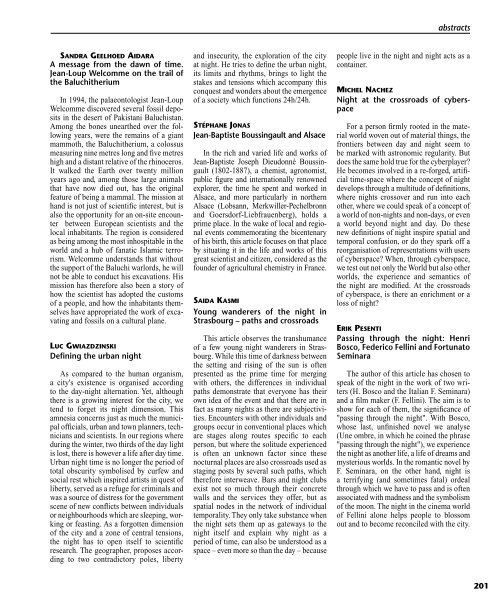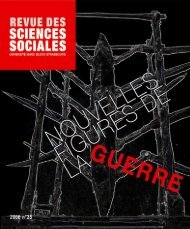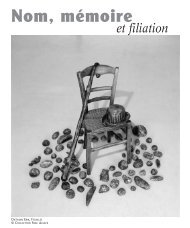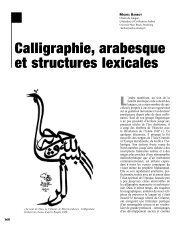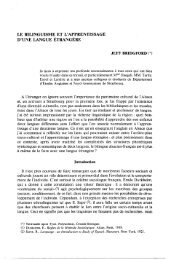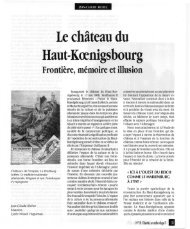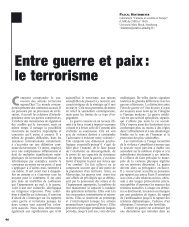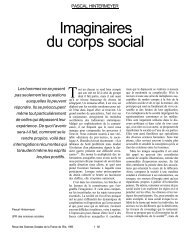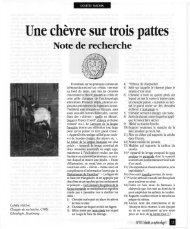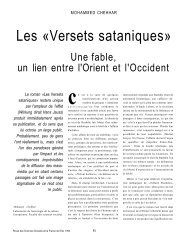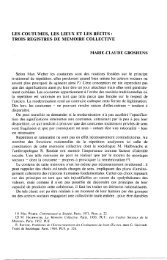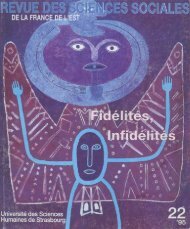Nos - Revue des sciences sociales
Nos - Revue des sciences sociales
Nos - Revue des sciences sociales
Create successful ePaper yourself
Turn your PDF publications into a flip-book with our unique Google optimized e-Paper software.
abstracts<br />
SANDRA GEELHOED AIDARA<br />
A message from the dawn of time.<br />
Jean-Loup Welcomme on the trail of<br />
the Baluchitherium<br />
In 1994, the palaeontologist Jean-Loup<br />
Welcomme discovered several fossil deposits<br />
in the <strong>des</strong>ert of Pakistani Baluchistan.<br />
Among the bones unearthed over the following<br />
years, were the remains of a giant<br />
mammoth, the Baluchitherium, a colossus<br />
measuring nine metres long and five metres<br />
high and a distant relative of the rhinoceros.<br />
It walked the Earth over twenty million<br />
years ago and, among those large animals<br />
that have now died out, has the original<br />
feature of being a mammal. The mission at<br />
hand is not just of scientific interest, but is<br />
also the opportunity for an on-site encounter<br />
between European scientists and the<br />
local inhabitants. The region is considered<br />
as being among the most inhospitable in the<br />
world and a hub of fanatic Islamic terrorism.<br />
Welcomme understands that without<br />
the support of the Baluchi warlords, he will<br />
not be able to conduct his excavations. His<br />
mission has therefore also been a story of<br />
how the scientist has adopted the customs<br />
of a people, and how the inhabitants themselves<br />
have appropriated the work of excavating<br />
and fossils on a cultural plane.<br />
LUC GWIAZDZINSKI<br />
Defining the urban night<br />
As compared to the human organism,<br />
a city's existence is organised according<br />
to the day-night alternation. Yet, although<br />
there is a growing interest for the city, we<br />
tend to forget its night dimension. This<br />
amnesia concerns just as much the municipal<br />
officials, urban and town planners, technicians<br />
and scientists. In our regions where<br />
during the winter, two thirds of the day light<br />
is lost, there is however a life after day time.<br />
Urban night time is no longer the period of<br />
total obscurity symbolised by curfew and<br />
social rest which inspired artists in quest of<br />
liberty, served as a refuge for criminals and<br />
was a source of distress for the government<br />
scene of new conflicts between individuals<br />
or neighbourhoods which are sleeping, working<br />
or feasting. As a forgotten dimension<br />
of the city and a zone of central tensions,<br />
the night has to open itself to scientific<br />
research. The geographer, proposes according<br />
to two contradictory poles, liberty<br />
and insecurity, the exploration of the city<br />
at night. He tries to define the urban night,<br />
its limits and rhythms, brings to light the<br />
stakes and tensions which accompany this<br />
conquest and wonders about the emergence<br />
of a society which functions 24h/24h.<br />
STÉPHANE JONAS<br />
Jean-Baptiste Boussingault and Alsace<br />
In the rich and varied life and works of<br />
Jean-Baptiste Joseph Dieudonné Boussingault<br />
(1802-1887), a chemist, agronomist,<br />
public figure and internationally renowned<br />
explorer, the time he spent and worked in<br />
Alsace, and more particularly in northern<br />
Alsace (Lobsann, Merkwiller-Pechelbronn<br />
and Goersdorf-Liebfrauenberg), holds a<br />
prime place. In the wake of local and regional<br />
events commemorating the bicentenary<br />
of his birth, this article focuses on that place<br />
by situating it in the life and works of this<br />
great scientist and citizen, considered as the<br />
founder of agricultural chemistry in France.<br />
SAIDA KASMI<br />
Young wanderers of the night in<br />
Strasbourg – paths and crossroads<br />
This article observes the transhumance<br />
of a few young night wanderers in Strasbourg.<br />
While this time of darkness between<br />
the setting and rising of the sun is often<br />
presented as the prime time for merging<br />
with others, the differences in individual<br />
paths demonstrate that everyone has their<br />
own idea of the event and that there are in<br />
fact as many nights as there are subjectivities.<br />
Encounters with other individuals and<br />
groups occur in conventional places which<br />
are stages along routes specific to each<br />
person, but where the solitude experienced<br />
is often an unknown factor since these<br />
nocturnal places are also crossroads used as<br />
staging posts by several such paths, which<br />
therefore interweave. Bars and night clubs<br />
exist not so much through their concrete<br />
walls and the services they offer, but as<br />
spatial no<strong>des</strong> in the network of individual<br />
temporality. They only take substance when<br />
the night sets them up as gateways to the<br />
night itself and explain why night as a<br />
period of time, can also be understood as a<br />
space – even more so than the day – because<br />
people live in the night and night acts as a<br />
container.<br />
MICHEL NACHEZ<br />
Night at the crossroads of cyberspace<br />
For a person firmly rooted in the material<br />
world woven out of material things, the<br />
frontiers between day and night seem to<br />
be marked with astronomic regularity. But<br />
does the same hold true for the cyberplayer?<br />
He becomes involved in a re-forged, artificial<br />
time-space where the concept of night<br />
develops through a multitude of definitions,<br />
where nights crossover and run into each<br />
other, where we could speak of a concept of<br />
a world of non-nights and non-days, or even<br />
a world beyond night and day. Do these<br />
new definitions of night inspire spatial and<br />
temporal confusion, or do they spark off a<br />
reorganisation of representations with users<br />
of cyberspace? When, through cyberspace,<br />
we test out not only the World but also other<br />
worlds, the experience and semantics of<br />
the night are modified. At the crossroads<br />
of cyberspace, is there an enrichment or a<br />
loss of night?<br />
ERIK PESENTI<br />
Passing through the night: Henri<br />
Bosco, Federico Fellini and Fortunato<br />
Seminara<br />
The author of this article has chosen to<br />
speak of the night in the work of two writers<br />
(H. Bosco and the Italian F. Seminara)<br />
and a film maker (F. Fellini). The aim is to<br />
show for each of them, the significance of<br />
"passing through the night". With Bosco,<br />
whose last, unfinished novel we analyse<br />
(Une ombre, in which he coined the phrase<br />
"passing through the night"), we experience<br />
the night as another life, a life of dreams and<br />
mysterious worlds. In the romantic novel by<br />
F. Seminara, on the other hand, night is<br />
a terrifying (and sometimes fatal) ordeal<br />
through which we have to pass and is often<br />
associated with madness and the symbolism<br />
of the moon. The night in the cinema world<br />
of Fellini alone helps people to blossom<br />
out and to become reconciled with the city.<br />
201


